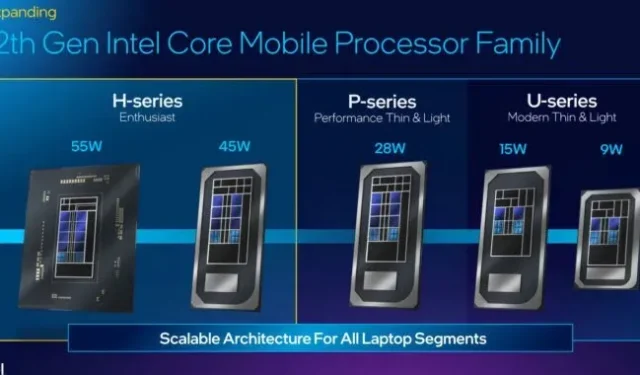Intel is cramming desktop Alder Lake processors into laptops with Core HX-series processors

Earlier this year, Intel announced three iterations of its 12th generation Alder Lake processor architecture for laptops: the U-series for thin and light ultrabooks, the P-series for thin-and-light workstation laptops, and the H-series for more powerful workstations and gaming laptops with plenty of room for large CPU fans and heatsinks.
Now Intel is adding another series of chips: the HX series, designed for even faster laptops. Despite sharing a letter with the H-series chips, the H and HX processors don’t have much in common. The H-series chips are larger versions of Intel laptop processors with more powerful integrated GPUs, integrated Thunderbolt, and an integrated chipset controller in the same package as the rest of the CPU. HX chips, on the other hand, use the same dies as desktop Intel Alder Lake chips, but are soldered to the laptop motherboard rather than plugged into a CPU socket.
| CPU | P- and E-cores | P-core clocks (Boost) | Basic design power | Turbo rated power |
|---|---|---|---|---|
| Core i5-12450HX | 4P/4E | 2.4 GHz (4.4 GHz) | 55 W | 157 W |
| Core i5-12600HX (vPro) | 4P/8E | 2.5 GHz (4.6 GHz) | 55 W | 157 W |
| Core i7-12650HX | 6P/8E | 2.0 GHz (4.7 GHz) | 55 W | 157 W |
| Core i7-12800HX | 8P/8E | 2.0 GHz (4.8 GHz) | 55 W | 157 W |
| Core i7-12850HX (vPro) | 8P/8E | 2.1 GHz (4.8 GHz) | 55 W | 157 W |
| Core i9-12900HX | 8P/8E | 2.3 GHz (5.0 GHz) | 55 W | 157 W |
| Core i9-12950HX (vPro) | 8P/8E | 2.3 GHz (5.0 GHz) | 55 W | 157 W |
These processors have a higher TDP than their H-series counterparts, with a base TDP of 55W instead of 45W and a 157W Turbo TDP rather than the 95 to 115W TDP of the H-series. The increase in power means these chips will run faster and longer than H-series processors due to higher power consumption and heat dissipation. However, our testing of these desktop processors shows that the Core i7 and i9 processors will benefit more from higher power limits than the lower core count versions of the Core i5.
Being a scaled down and repackaged desktop processor, it offers some advantages and disadvantages over conventional H-series laptop processors. On the positive side, the Core i7 and Core i9 chips offer an extra pair of P-cores and eight efficient cores for 16 streams. As long as your laptop can handle the extra power requirements, it should be good for CPU performance and rendering tasks.
These processors also support PCI Express 5.0, although it doesn’t make much sense yet – modern GPUs and SSDs don’t use the new standard yet and won’t use it anytime soon. They also support memory overclocking just like their desktop counterparts, and the vPro compatible versions also support ECC memory.
Whether you will be bothered by flaws depends on what you are doing. The chips’ maximum number of integrated GPUs is 32 execution units (EU), compared to a maximum of 96 in H-series processors. Notebooks with HX processors will almost certainly include dedicated GPUs, which is usually not a big deal, but processors’ lack of onboard connectivity Thunderbolt 4 is more egregious. You can add up to two dedicated Thunderbolt controllers, but this adds cost and complexity.
The Core i7 and i9 HX-series chips might make sense for people who want all the CPU performance they can get in a laptop, but the odd Core i5 HX offerings are probably best avoided. They only include four P cores and four or eight E cores, no more than regular H-series chips, and with that many cores, they are unlikely to benefit much from their increased TDP.
Intel did not give a specific date for the availability of laptops with HX-series processors, but said that “more than 10 workstation and gaming models”will be released by PC manufacturers “this year.”
Image listing from Intel
Leave a Reply